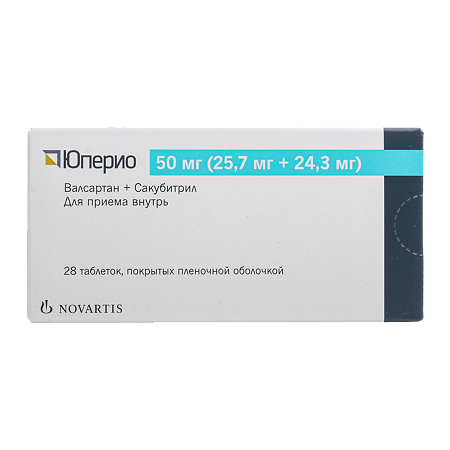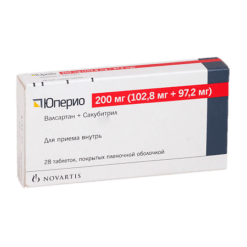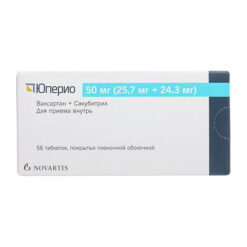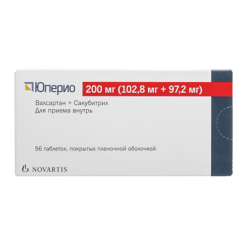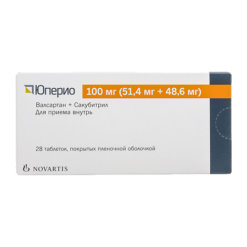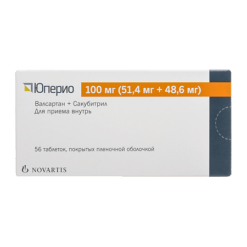No products in the cart.
Huperio, 50 mg 28 pcs.
€67.11 €55.92
Description
The action of Huperio is mediated by a new mechanism, namely, the simultaneous inhibition of neprilysin activity (neutral endopeptidase, NEP) by the substance LBQ657 (active metabolite of sacubitril) and blockade of angiotensin II type 1 receptors (AT1) by valsartan, which is an angiotensin II receptor antagonist (APA II).
Indications
Indications
Chronic heart failure (NYHA class II-IV) in patients with systolic dysfunction to reduce the risk of cardiovascular mortality and hospitalization for heart failure.
The drug is used in combination therapy with other drugs for the treatment of chronic heart failure as a replacement for angiotensin-converting enzyme inhibitors (ACEIs) or angiotensin II receptor antagonists (ARA II).
Essential arterial hypertension.
Pharmacological effect
Pharmacological effect
The action of the drug Uperio is mediated by a new mechanism, namely, the simultaneous suppression of the activity of neprilysin (neutral endopeptidase (NEP)) by the substance LBQ657 (the active metabolite of sacubitril) and blockade of receptors for angiotensin II type 1 (AT1) by valsartan, which is an antagonist of angiotensin II receptors (APA II).
Special instructions
Special instructions
Marked decrease in blood pressure
Cases of clinically significant arterial hypotension have been reported in patients receiving Uperio. If a pronounced decrease in blood pressure occurs, you should consider adjusting the dose of diuretics, concomitant antihypertensive drugs, as well as eliminating the causes of a pronounced decrease in blood pressure (for example, hypovolemia). If, despite these measures, a pronounced decrease in blood pressure persists, the dose of Uperio should be reduced or the drug should be discontinued for a while. Final discontinuation of the drug is usually not required. The likelihood of a significant decrease in blood pressure is generally greater in patients with hypovolemia, which may be caused by diuretic therapy, a low-salt diet, diarrhea or vomiting.
Before starting to use the drug Uperio, you should correct the sodium content in the body and/or replenish the blood volume.
Renal dysfunction
Like any other drug that acts on the RAAS, Uperio can cause deterioration in kidney function. In a comparative study of safety and effectiveness 14/17 (compared with enalapril), clinically significant impairment of renal function was rarely observed, and Uperio was discontinued due to such impairments less frequently (0.65%) than enalapril (1.28%). In the event of a clinically significant deterioration in renal function, a dose reduction of Uperio should be considered. When using the drug Uperio in patients with severe renal impairment, caution should be exercised.
Hyperkalemia
Like any other drug that acts on the RAAS, Uperio may increase the risk of developing hyperkalemia. In a comparative safety and efficacy study (versus enalapril), clinically significant hyperkalemia was rare; Uperio was discontinued due to hyperkalemia in 0.26% of patients, and enalapril in 0.35% of patients. Drugs that can increase the level of potassium in the blood serum (for example, potassium-sparing diuretics, potassium supplements) should be used concomitantly with Uperio with caution. If clinically significant hyperkalemia occurs, measures such as reducing dietary potassium intake or adjusting the dose of concomitant medications should be considered. It is recommended to regularly monitor serum potassium levels, especially in patients with risk factors such as severe renal impairment, diabetes mellitus, hypoaldosteronism or a diet high in potassium.
Angioedema
During the use of the drug Uperio, cases of the development of angioedema have been reported. If angioedema occurs, the drug Uperio should be immediately discontinued and appropriate treatment and monitoring of the patient should be prescribed until all symptoms have completely and permanently resolved. Uperio should not be re-prescribed. In cases of confirmed angioedema, in which the swelling extends only to the face and lips, the condition usually resolves without intervention, although the use of antihistamines helps relieve symptoms.
Angioedema, accompanied by swelling of the larynx, can be fatal. In cases where swelling extends to the tongue, vocal folds or larynx, which may lead to airway obstruction, appropriate treatment, such as subcutaneous injection of epinephrine (adrenaline) 1:1000 solution (0.3-0.5 ml), should be started immediately and/or appropriate airway measures should be taken.
In patients with a history of angioedema caused by the use of an ACE inhibitor or ARB II, Uperio should not be used. Black patients may be more at risk of angioedema.
Patients with renal artery stenosis
Like other drugs acting on the RAAS, Uperio may cause increases in serum urea and creatinine concentrations in patients with unilateral or bilateral renal artery stenosis. In patients with renal artery stenosis, the drug should be used with caution, regularly monitoring renal function.
Impact on the ability to drive vehicles and/or machinery
There is no data on the effect of the drug on the ability to drive vehicles and/or machines. Due to the possible occurrence of dizziness or increased fatigue, caution should be exercised when driving vehicles or operating machinery.
Active ingredient
Active ingredient
Valsartan, Sacubitril
Composition
Composition
1 film-coated tablet, 50 mg (25.7 mg + 24.3 mg) contains:
Active ingredient:
sacubitril and valsartan hydrate complex of sodium salts – 56.551 mg (in terms of the anhydrous acid form 50 mg, which is equivalent to the content of 24.3 mg of sacubitril and 25.7 mg of valsartan);
excipients:
microcrystalline cellulose – 91.449 mg,
hyprolose – 25,000 mg,
crospovidone – 18,000 mg,
magnesium stearate – 6,000 mg,
talc – 2,000 mg,
colloidal silicon dioxide – 1,000 mg;
shell:
white shell premix – 7.957 mg (hypromellose – 5.681 mg, titanium dioxide – 1.138 mg, macrogol 4000 – 0.569 mg, talc – 0.569 mg), red shell premix – 0.019 mg (hypromellose – 0.014 mg, red iron oxide dye – 0.003 mg, macrogol 4000 -0.001 mg, talc – 0.001 mg), black shell premix – 0.024 mg (hypromellose – 0.017 mg, black iron oxide dye – 0.003 mg, macrogol 4000 – 0.002 mg, talc – 0.002 mg).
Pregnancy
Pregnancy
Patients with preserved reproductive potential should be informed about the possible consequences of using the drug during pregnancy, as well as the need to use reliable methods of contraception during treatment with the drug and for a week after its last dose.
Contraindications
Contraindications
Hypersensitivity to sacubitril or valsartan, as well as to other auxiliary components of the drug.
Concomitant use with angiotensin-converting enzyme (ACE) inhibitors, as well as a period of 36 hours after discontinuation of ACE inhibitors.
A history of angioedema due to previous therapy with ACE inhibitors or ARB II.
Concomitant use of aliskiren in patients with diabetes mellitus or in patients with moderate or severe renal impairment (eGFR)
Severe liver dysfunction (Child Pugh class C), biliary cirrhosis and cholestasis.
Inresto is not recommended for use in children under 18 years of age due to the lack of data on efficacy and safety.
Pregnancy, pregnancy planning and breastfeeding.
Simultaneous use with other drugs containing ARA II, because The drug contains valsartan.
With caution
Caution should be exercised when using Uperio in patients with severe renal impairment (eGFR
Caution should be exercised when using the drug simultaneously with statins and phosphodiesterase type 5 inhibitors.
Caution should be exercised when using the drug in patients with a history of angioedema due to the lack of data on the use of the drug in patients in this category. Black patients may be at greater risk of angioedema.
Side Effects
Side Effects
The identified adverse events (AEs) were consistent with the pharmacological characteristics of the drug Uperio and the concomitant diseases present in the patients. The most common adverse events were a marked decrease in blood pressure, hyperkalemia and renal dysfunction caused by dose adjustment of Uperio or discontinuation of therapy. The frequency of AEs did not depend on the gender, age or race of patients.
AEs are listed according to the organ system class of the MedDRA Medical Dictionary for Regulatory Activities. Within each systemic organ class, AEs are distributed by frequency of occurrence in order of decreasing importance. The following criteria were used to assess frequency: very often (1/10); often (from 1/100 to Metabolic and nutritional disorders: very often – hyperkalemia; often – hypokalemia.
Nervous system disorders: often – dizziness, headache; infrequently – orthostatic dizziness.
Hearing and labyrinthine disorders: often – vertigo.
Vascular disorders: very often – marked decrease in blood pressure; often – fainting, orthostatic hypotension.
Disorders of the respiratory system, chest and mediastinal organs: often – cough.
Gastrointestinal disorders: often – diarrhea, nausea.
Skin and subcutaneous tissue disorders: uncommon – angioedema.
Renal and urinary tract disorders: very often – renal dysfunction; often – renal failure (including acute renal failure).
General disorders and disorders at the injection site: often – increased fatigue, asthenia.
If any of the side effects indicated in the instructions get worse, or you notice any other side effects not listed in the instructions, tell your doctor.
Interaction
Interaction
Contraindicated drug interactions ACE inhibitors Uperio is contraindicated for use simultaneously with ACE inhibitors, since suppression of neprilysin simultaneously with the use of an ACE inhibitor may increase the risk of developing angioedema.
The use of the drug Uperio is possible no earlier than 36 hours after discontinuation of the ACE inhibitor. The use of an ACE inhibitor is possible no earlier than 36 hours after the last dose of Uperio.
Aliskiren
In patients with diabetes mellitus and in patients with impaired renal function (eGFR
Not recommended drug interactions
Angiotensin receptor antagonists
Since one of the active ingredients of the drug is an angiotensin II receptor antagonist, simultaneous use with another drug containing ARA II is not recommended.
Drug interactions to consider
HMG-CoA reductase inhibitors (statins)
Research data show that sacubitril inhibits the activity of the OATP1B1 and OATP1B3 transporters. Uperio may increase the systemic exposure of OATP1B1 and OATP1B3 substrates such as statins. In patients receiving Uperio simultaneously with atorvastatin, the maximum plasma concentration (Cmax) of atorvastatin and its metabolites increased up to 2 times, and AUC increased up to 1.3 times. For this reason, Uperio should be used concomitantly with statins with caution.
Sildenafil
In patients with a marked increase in blood pressure receiving Uperio (until equilibrium concentrations were reached), a single dose of sildenafil enhanced the antihypertensive effect compared with the use of Uperio in monotherapy. For this reason, sildenafil or another phosphodiesterase type 5 inhibitor should be used with caution in patients receiving Uperio.
Suspected drug interactions to consider
Potassium
Concomitant use of potassium-sparing diuretics (for example, triamterene and amiloride), mineralocorticoid antagonists (for example, spironolactone and eplerenone), potassium supplements or potassium-containing salt substitutes may cause an increase in potassium and creatinine concentrations in the blood serum. In patients receiving Uperio concomitantly with these drugs, it is recommended to regularly monitor serum potassium levels.
Nonsteroidal anti-inflammatory drugs (NSAIDs), including selective cyclooxygenase-2 inhibitors (COX-2 inhibitors)
The use of Uperio concomitantly with NSAIDs in patients over the age of 65 years, in patients with hypovolemia (including patients receiving diuretics) and in patients with impaired renal function may increase the risk of deterioration of renal function. In patients receiving Uperio concomitantly with NSAIDs, it is recommended to monitor renal function when prescribing such a treatment regimen and in case of changes in it.
Lithium preparations
The possibility of drug interactions between Uperio and lithium preparations has not been studied. With the simultaneous use of lithium preparations with ACE inhibitors and ARA II, a reversible increase in the concentration of lithium in the blood serum was observed and, in connection with this, an increase in toxic manifestations. In patients receiving Uperio together with lithium preparations, it is recommended to carefully monitor the lithium content in the blood serum. If a diuretic drug is used additionally, the risk of lithium toxicity may increase.
Transport proteins
The active metabolite of sacubitril (LBQ657) and valsartan are substrates of the transporter proteins 0ATP1B1, 0ATP1B3 and OATZ; valsartan is also a substrate of the MRP2 transporter protein. In patients receiving Uperio concomitantly with OATP1B1, OATP1B3, OATZ (e.g., rifampicin and cyclosporine), or MRP2 (e.g., ritonavir) inhibitors, systemic exposure to LBQ657 or valsartan, respectively, may be increased. Caution must be exercised at the beginning and at the time of completion of the combined use of the drug Uperio and this group of drugs.
No significant drug interactions
When Uperio was used in combination with furosemide, digoxin, warfarin, hydrochlorothiazide, amlodipine, metformin, omeprazole, carvedilol, intravenous (IV) nitroglycerin or a combination drug of levonorgestrel and ethinyl estradiol, no clinically significant interactions were identified.
Interactions with atenolol, indomethacin, glibenclamide (glyburide) or cimetidine are not expected when used together with Uperio.
Interactions with isoenzymes of the cytochrome P450 system
Available studies demonstrate that the likelihood of drug interactions mediated by cytochrome CYP450 isoenzymes is low, since the complex of active substances is metabolized to a small extent with the participation of CYP450 isoenzymes. The complex of active ingredients of the drug Uperio is not an inhibitor or inducer of CYP450 isoenzymes.
Overdose
Overdose
There is insufficient data on overdose of Uperio in humans. A single dose of 1200 mg and multiple doses of 900 mg in healthy volunteers were well tolerated.
The most likely symptom of an overdose is a pronounced decrease in blood pressure due to the antihypertensive effect of the active substances. In this case, symptomatic treatment is recommended.
In case of accidental overdose, induce vomiting (if the drug was taken recently) or perform gastric lavage. In the event of a pronounced decrease in blood pressure, intravenous administration of a 0.9% sodium chloride solution is necessary as therapy; the patient should be placed with his legs elevated for the period of time required for therapy, and active measures should be taken to maintain the activity of the cardiovascular system, including regular monitoring of the activity of the heart and respiratory system, circulating blood volume (CBV) and the amount of urine excreted. Removal of active substances during hemodialysis is unlikely, since a significant part of them binds to blood plasma proteins.
Storage conditions
Storage conditions
At a temperature not higher than 25° C.
Shelf life
Shelf life
30 months.
The drug should not be used after the expiration date.
Manufacturer
Manufacturer
Novartis Neva LLC, Russia
Additional information
| Shelf life | 30 months. The drug should not be used after the expiration date. |
|---|---|
| Conditions of storage | At a temperature not exceeding 25° C. |
| Manufacturer | Novartis Neva LLC, Russia |
| Medication form | pills |
| Brand | Novartis Neva LLC |
Other forms…
Related products
Buy Huperio, 50 mg 28 pcs. with delivery to USA, UK, Europe and over 120 other countries.

